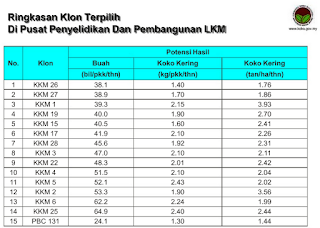....Ketika berdialog dengan warga, Presiden me–
ngatakan bahwa pemerintah telah menganggarkan dana Rp1,2 triliun un-
tuk memperbaiki perkebunan kakao Indonesia. Anggaran tersebut dihimpun
untuk mendukung target Indonesia menjadi produsen kakao terbesar dunia
pada 2020....
Link: http://www.slideshare.net/IgorRangga/cokelat-10emailv2
Saturday, September 3, 2016
Indonesia Invest Rp1.2 Trillion to become world's No.1 Cacao Producer by 2020
Malaysian Cocoa Board - ICCO - CABI Market Studies (STDF, Hussain, June2014)
What's your type.... chocolate?
Cacao Sabah Planter..... chef?
Cacao farm planting material variety, will this combination be a winner!
Planting at least 3 cacao variety, preferably clonal grafted cacao variety is recommended by commercial cacao farming. Presently, considering P&D susceptibility, fine-flavor traits and productivity of each available cacao variety, is this combination good enough to storm the weather of sustainability for the next 20-years of the cacao farm economic life: BR25 + CH2 (USM) + W10 (ACS,Davao)
Friday, September 2, 2016
Malaysian Cacao Clone... recommended variety
Link: http://animhosnan.blogspot.com/2015/01/koko-varieti-di-syorkan.html
Cacao innovations... study to utilize cacao pod husks for fibre-glass production
Link: http://eprints.utem.edu.my/5189/2/A_Mechanical_Study_On_Cocoa_Husk-Glass_Fibre__Polypropylene_(PP)_Hybrid_Composite.pdf
How to Make IMO (Indigenous Microorganisms) May 22, 2016 BusinessDiary
How to Make IMO (Indigenous Microorganisms (Business Diary)) May22,2016 In natural farming, Indigenous Microorganism (IMO) is becoming popular among farmers. This Indigenous microorganism (IMO) has been successfully tried by government agriculturists, academic researchers, non-profit organizations and farmers alike. They have found that IMO is useful in removing bad odors from animal wastes, hastening composting, and contributing to crops’ general health. Beneficial Indigenous Microorganism (BIM) How to Make Your Own Indigenous Microorganism (IMO): 1. Cook a kilo of rice, preferably organic. After cooling, put the cooked rice in a wooden, earthen or ceramic container. Avoid plastic or aluminum. 2. Cover the mouth of the container completely with cloth or paper, fixed in place with a rubber band, to prevent water or small insects from getting in. 3. Put the covered container, protected from possible rain, under the trees, in a bamboo grove, a forest floor, or wherever a thick mat of leaves has formed. Leave it there for three days. 4. After whitish moldy filaments have formed, transfer the entire contents of the container to a larger glass or earthen jar and add one kilo of brown sugar or molasses, preferably organic. 5. Cover the jar with clean cloth or paper, fixed with a rubber band. Keep the jar in a dark, cool place. Let it ferment for seven days, until it appears muddy. This is your IMO concoction. How to Use Indigenous Microorganism (IMO) Mix two spoonfuls of the concoction with a liter of water. Spray the diluted solution around chicken coops and pig pens to remove unpleasant odors, on your compost pile to hasten decomposition, or on your crops to improve their general health by controlling pests and serving as foliar fertilizer. By making your own Indigenous Microorganisms (IMO), you can free yourself of buying costly harmful chemicals and make a lot of savings while maintaining good bacteria in your area.



























